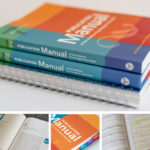The short answer is yes, double-spacing documents is a key requirement of APA format. But I hope you’ll stick around, because line spacing is the tip of the iceberg when it comes to knowing the ins and outs of what can be a tricky format to learn and use effectively. When it comes to APA style, it pays to take the time to learn the basics and understand the rationale behind one of academia’s most pervasive style guides.
These are a few frequently-asked questions about double-spacing documents written in APA:
- What is APA style?
- Why is APA double-spaced?
- What are other conventions of APA?
- Why do I need to learn APA?
What is APA Style?
APA is the official style format used by the American Psychological Association. All of the rules governing APA style are compiled in the Publication Manual of the American Psychological Association (7th edition). APA style establishes conventions for every aspect of academic writing, from double-spacing paragraphs to headings to in-text citation and references. APA is the official style used in psychology, education, and the sciences, as well as other academic disciplines.

APA is one of several styles used in academic writing. The Modern Language Association’s MLA format is used in the humanities and liberal arts (it is also frequently taught in high schools), and it has significant distinctions from APA. Other popular styles are Chicago (also known as Turabian) and Harvard style. Use of these styles and their modifications depends on discipline and institution. Every peer reviewed scholarly or literary journal adheres to a specific style in their publications, so it’s important to know what they use prior to submission.
As an English professor raised on MLA format during college and graduate school, it took me a while to get the hang of APA style when I joined the faculty at a STEM institution. If you’re in the same boat and feeling intimidated by learning the language of APA, have no fear. Though it takes some time to learn the features of APA, I find it to be an intuitive style that’s pretty easy to master once you commit to it. Plus, there are a lot of excellent, reliable resources to turn to if you get confused.
Why is APA Double-Spaced?
As with most questions related to APA, the answer is organization and clarity. The primary goal of APA style is to bring order to the chaos that often comes with academic scholarship. Whether you are working with a few or dozens or hundreds of sources, APA style is designed to tame the discord and keep the scholarly train on the tracks. By offering a standard framework for every aspect of a document, APA style helps ensure that documents are clear and accessible.

When I’m working with students at any level, one thing that I like to emphasize is the value of APA style to them as scholars. Having a formal system for formatting and citation creates continuity throughout not just one document, but every text within that system. Once you understand how APA operates–and why–you have greater insight into the inner workings of academic scholarship and the principles that it prizes most.
Conventions of APA
APA format is the reason for the uniform appearance of all of the scholarship in every discipline that adheres to it. It’s why every dissertation looks the same, regardless of the author’s degree-granting institution. The APA manual has very clear opinions on every aspect of an article, book, or dissertation, from their outward appearance to their internal structure.
In addition to line spacing, APA style dictates every visual element that we associate with APA. This includes headings, page numbers, font, headers, and footnotes, to name a few. Charts, graphs, appendices, and even the structure of the table of contents also fall under the purview of APA format. But as much as the appearance of a document like your dissertation is influenced by the style, the bulk of APA’s might is exerted on how we use and cite scholarly sources.
One of the best descriptions of citation I’ve heard likens it to solving a complex math problem by hand. Just like in middle school algebra, you’ve got to show your work. APA format requires you to show the source of every concept that isn’t common knowledge, making the researcher account for every direct quote, paraphrase, and even idea that isn’t their own original work. And by using APA’s strict format for in-text citations and references, the system protects that research and makes sure that every scholar gets credit for their ideas.
Learning APA Format

In the age of online citation engines that can churn out hundreds of citations in minutes, you may be wondering if you even need to learn APA style for yourself. While these services can prove to be invaluable when you’re compiling hundreds of sources, they are not infallible. As a faculty member who has served on many dissertation committees, I’ve worked with plenty of students who have had to make 11th hour corrections to their dissertations when the software they relied on to format their references made mistakes.
The best way to avoid the stress of receiving a last-minute request for corrections from your dissertation committee is to have a sound understanding of APA format yourself. Knowing the basics of how to format in-text citations and references will put you in the driver’s seat and help you maintain control over the integrity of your document. Even if you choose to use a citation machine, you’ll still be able to confirm whether or not your references are correct with a quick scan of the text.
Having a firm grasp of APA is a great skill to hone while in graduate school. It will serve you well during your coursework and also when you’re working on your dissertation. More than anything, knowing the ins-and-outs of APA style will offer you a little extra peace of mind, which is an invaluable commodity in graduate school.






